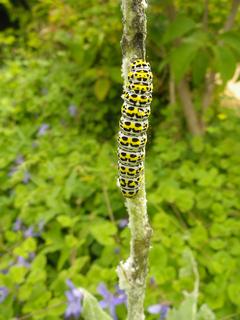 |
Mullein moth larva on Verbascum pulverulentum
Photo by Keith Barnett |
Worcestershire Record No. 23 November 2007 p. 47
Keith Barnet
Last summer (2007) I noticed that the leaves and flowering spike of a Hoary Mullein Verbascum pulverulentum being cultivated in my Malvern garden were being devoured by caterpillars of the Mullein Moth Cucillia verbasci. Whilst such attacks on the Great Mullein or Aaron’s Rod V. thapsus are not infrequently seen, and particularly bad ones can completely defoliate a plant, I do not know how often the Hoary Mullein (a native of East Anglia, mostly Norfolk) falls victim.
 |
Mullein moth larva on Verbascum pulverulentum
Photo by Keith Barnett |
The Mullein Moth is a noctuid (nocturnal) moth that flies between April and June but is rarely seen as an adult. It is well disguised, having streaky brown front wings and a tuft of hair on the thorax, which give a striking resemblance in daylight to a broken twig. One brood is produced each year. During late April and May the adult moth emerges and lays eggs on the host plant, the caterpillars (larvae) being active between late May and mid-July. It reportedly feeds not only ‘mulleins’ but also on Common Figwort Scrophularia nodosa and Orange-ball-tree Buddleja globosa. When fully fed, they go into the soil where, in a process that can take up to four years, they pupate inside silk cocoons. The caterpillar is up to 5 cm long, greyish-white with bold, prominent black and yellow eye-like spots (photograph) which probably warn predators of its unpleasant taste. They are nevertheless parasitised by the larvae of the ichneumon wasp Option luteus.
Although the plant in my garden looked a sorry specimen after the caterpillars’ attention, it was not killed and recovered after their apparently overnight departure to produce several new flowering spikes.
| WBRC Home | Worcs Record Listing by Issue | Worcs Record Listing by Subject |